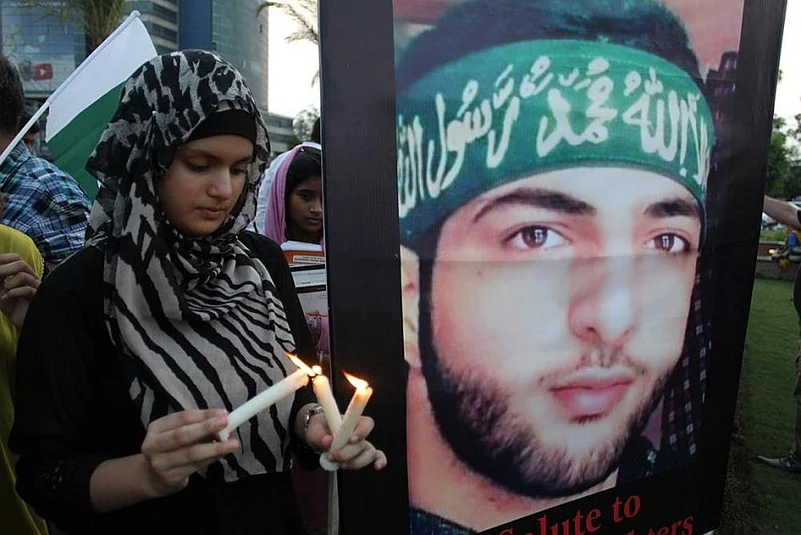A crackdown of Jammu and Kashmir Police to contain the volatile situation has led to arrest of over 7000 protesters involved in stone throwing in the valley. The protests triggered following the killing of 21-year-old Hizbul Mujahedeen commander, Burhan Muzaffer Wani. Despite Wani's killing his name surfaced at hundreds of places across Kashmir region. Burhan's town, Burhan Colony, Burhan Chowk, etc., are the graffitis scribbled on walls of the neighbourhoods in almost all towns and villages in the Valley.
A police study aimed at understanding the genesis of large scale protests in the aftermath of Wani's killing gives credit to the militant commander for galvanizing militancy and popularizing it in the Valley, bringing it to the level to early 1990s.
Advertisement
The police says the militant commander was young, suave, educated and used these qualities to the advantage of militancy by employing “mixture of successful guerrilla tactics to modern worldwide techniques of warfare”.
As over 2 lakh people are estimated to have participated in his funeral, the police says acceptance and fame of the Hizbul Mujahedeen militant organisation grew in Kashmir after Wani adopted methods usually unknown in the guerrilla warfare, thus giving huge mileage to Hizbul, which became largest militant organisation in his time.
Wan's lifted veil of secrecy from the militancy by allowing posting of his pictures on the social networking sites like Facebook and Twitter. This, the police say, made him like Chee Guevara and increased his fame among the masses.
Advertisement
Unlike militant commanders of yesteryears, police argues, Wani used the media as message to project an image of Kashmiri militant. He galvanized the militancy and glamourized it, says the study.
Experts say under the guerrilla tactics, the militant should adopt 90 per cent safety measures. But the police says Burhan again flouted the rule with sole aim to get support for the militants.
“After 1992, it is the first that militants are enjoying support that borders to an abnormality as people rush to save militants and defy police cordons during gunfights instead of running away from the spots,” a police official said.
Since Wani's funeral witnessed biggest congregation of past one decade in Kashmir Valley, the police attributed several engagements of security forces as possible reasons that failed to tackle massive protests in the aftermath of his killing.
At least 90 protesters were killed and over 10000 wounded, some of them blinded and maimed as the government forces fired pellets and bullets to tackle protesters.
The police says a large number of security forces personnel were deputed for annual Hindu pilgrimage of Amarnath Yatra and with by-election in Anantnag assembly constituency, which was won by Mehbooba Mufti.
The study also reveals that there was latent anger in the Valley over the government handling of implementation of Food Security Act, the voices from some politicians insisting on abrogation of the Article 370, establishing of Sainik colonies and separate colonies for Hindus in the Kashmir region.
Advertisement
The study found political parties of complicating the issue by making protests at the National Institute of Technology (NIT) in Srinagar as India versus Kashmir issue. Besides the killings of protesters including well-known cricketer at Handwara, in frontier Kupwara district, over the alleged molestation of a minor girl, gave impetus to the anger, police said.
“All it needed a trigger,” says police official associated with the study. "After Burhan’s killing people poured on the streets leading to chaos."
The police says unlike 2008 or 2010 mass protests, in 2016 summer agitation militants openly addressed the rallies making it as deadly mix. The police called 2016 protests as militant driven as after the Wan's killing militants addressed rallies at several places, a reminiscent of 1990s.
Advertisement
The police says during 2016 agitation, 62 government establishments including police stations and schools were burnt.
With unrest at its peak, the police analysis said, Pakistan contributed its bit by organising July 19 as black day in protest against Kashmir killings and later described “movement of Kashmiris as freedom movement” and it was approved by the cabinet in Pakistan.
In post-Burhan period, the local militant recruits have gone up in south Kashmir with around 50 more youth joining militancy. From Shopian alone, 14 youngsters have joined militancy while as from Kulgam in south Kashmir, the number is 12.
The police says unlike south, north is dominated by Lashker Toiba militants and Srinagar has most lethal gruella militants as they don’t come into open and have no media or social media presence. According to the police, Srinagar has presence of around 15 militants.
Advertisement
Giving overall picture of the situation the study says, Kashmir will continue to face challenges as there are 50,000 unaddressed victims “terrorism and state violence” over 30 separatist organisations, over 10,000 disappeared.
The police study is contrary to the Chief Minister's initial remarks that only five per cent of people are supporting the agitation.




















